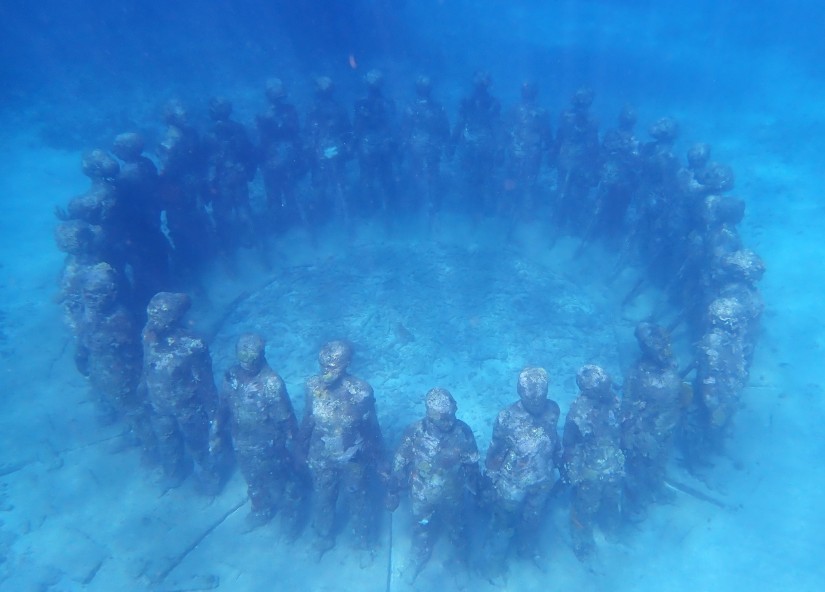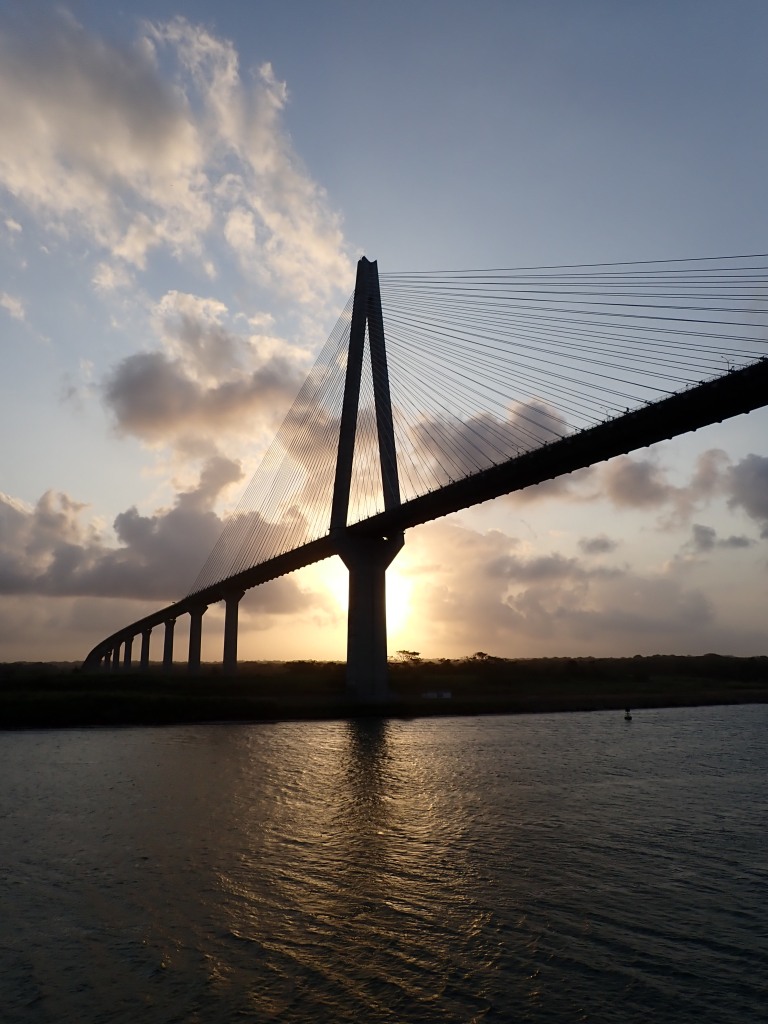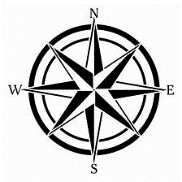Tom and I last visited the island of Grenada in 1992, when we sailed our own humble 38-foot sailboat into St. George Harbor.

We were pleased to see not much has changed and that the waterfront promenade called The Carenage, has retained its Caribbean charm.

Some modest modernization has occurred, but the open-air Market Square was still full, colorful, and boisterous, with vendors hawking their spices and produce on a Saturday.


But there was something new to see for us, and we jumped right in! The Molinere Underwater Sculpture Park was established in 2004 as a means of promoting coral reestablishment and growth, after the devastation of Hurricane Ivan. Sixty-five cement sculptures have been placed on the seabed within an area of 800 square meters and are doing a great job of bringing back coral, fish and tourists. Snorkeling in and around these sculptures is somewhat an eerie experience, as they loomed into view.





After snorkeling, we spent some time on beautiful Grand Anse beach before heading back into town.

Grenada, known as the Island of Spice, will always hold a special place in our hearts.

Willemstad, Curacao The delightful pastel-colored buildings that line Willemstad’s iconic waterfront welcome the Zuiderdam in the early morning hours.

We spent a few wonderful weeks scuba diving in Curacao back in 2011 and were anxious to get back in their beautiful waters. Our shipmate friend Lydia joined us for a one-tank shore dive in the morning.




The afternoon was spent with Derek, a local friend whom we met on last year’s cruise. He hosted lunch for several of us at a beachside restaurant and afterwards, we visited his lovely home. What a great day spent in Curacao!



The moon was going down over the Pacific, as the sun was coming up over the Caribbean Sea. Zuiderdam eased her way through the Limon Bay to begin her Panama Canal transit.
We were awake early and stationed ourselves in The Crows Nest observation deck by 6:30am for prime viewing of the day-long transit that would take us beneath bridges, through winding channels, locks and lakes of this 50-mile engineering marvel.

To begin, we pass beneath the Atlantic Bridge (completed in 2019), which spans the Atlantic entrance to the canal.

Then onto the Gatun Locks, three sets of double-lock chambers bring hulking ships almost 100 feet above the water, from the Caribbean Sea into the man-made Gatun Lake. The lake encompasses 166 square miles, and the surface sits at an elevation around 85 feet above sea level.

From there, it’s through the Culebra Cut, an excavated gorge stretching more than 8 miles across the Continental Divide.

We are then lowered about 30 feet in the Pedro Miguel Locks, transit the small body of Miraflores Lake before descending another 54 feet in the Miraflores Locks.


And lastly, we pass beneath the enormous Bridge of the Americas, that was completed in 1962 at a cost of $20 million. At 5,425 feet long (almost a mile), the bridge is a key part of the Pan-American highway.
After a long, hot day on the canal, the ship created a casual “Burgers & Beer” event with live music at the Lido Pool.

Exiting the Panama Canal, we are now in the Pacific Ocean, making our way northwest along the coast towards Quepos, Costa Rica.
With 800 miles of gorgeous coastline and 25% of the country’s land protected as national park, it’s no wonder why the local mantra is “Pura Vida” meaning Pure Life. Beaches, coral reefs, rainforests provide the good life, for sure!

At 7am we anchored just outside of Quepos, a small town (pop. 22,000) on the Pacific coast, known as the Gateway to Manuel Antonio National Park, only a few miles away.
But Quepos is also famous for world-class sport fishing, like blue marlin and sailfish. The Marina Pez Vela is home to an impressive fleet of sleek sport fish yachts, shops and restaurants, and where our tenders land us ashore.

We had visited the national park several years ago and saw the incredible array of sloths, monkeys, and tropical birds. But since our port call was relatively short today (3:30pm), we opted to explore Quepos.

A short walk along the broad harbor brings us to the 6-block village center where locals are busy getting ready for the weekend. We enjoyed milling the streets and popping into variety and souvenir shops. Additionally, we made frequent stops at “Sodas” which are small casual eateries, to cool ourselves and rehydrate in the 90-degree heat and humidity.


From Quepos, it would be a two-day run northwest towards Manzanillo, Mexico. During the first overnight, Zuiderdam experienced anticipated 50- knot winds and higher gusts, and we felt the impact of 17-foot waves, as confirmed by Captain Frank the next morning. This area is prone to the phenomena of “Tehuantepecer”, or Tehuano winds. According to Wikipedia, it is described as a violent mountain-gap wind that travels through the Chivela Pass in southern Mexico, across the Isthmus of Tehuantepec. It originates from eastern Mexico and the Bay of Campeche as a post-frontal northerly wind, accelerated southward by cold air damming, that crosses the isthmus and blows through the gap between the Mexican and Guatemalan mountains. With all that explanation aside, a picture is worth a thousand words. Here is the Ventusky.com capture of the conditions at 2am from Tom’s phone:

Captain Frank also shared that they filled the ships ballast tanks with water to counter the force of the wind heeling the ship to port, and she handled the conditions easily.

Manzanillo offers the coastal charm of old Mexico. The seaside boardwalk and park welcome visitors with brightly painted metal sculptures, including their enormous swordfish sculpture boasting that Manzanillo is the sailfish capital of the world.

Meandering the streets to El Centro and the Mercado we experienced all the sights, smells, and sounds of this bustling port city.


Lots of colonial architecture, and a surprising number of old VW’s driving around.


There were numerous tortillerias, or “tortilla factories”, which were spartan open-air store front with a mechanized machine that would extrude, flatten and stack tortillas all day long.

Further up the Mexican coast, Puerto Vallarta comes into view against the backdrop of the Sierra Madre mountains.

It’s a city that blends old and new. Where quiet cobblestone streets and family-owned businesses of Old Vallarta are not far from the lively beach strands of sleek resorts, high-rise living and luxury shopping.

What better way to experience a slice of life here, than cooking with a local?! We rendezvoused with Manu at the traditional Mexican marketplace that included fruits and vegetables, a tortilleria for fresh tortillas, a carnicería (butcher), and a pescadería (fish market).
After completing culinary school in his hometown of Guadalajara, he traveled abroad and lived in Canada, Spain, and Norway where he worked in a series of professional kitchens. After being away for 6 years, Manu returned to Mexico where he could indulge in his love of the food from home.

After shopping for all our fresh ingredients, he drove us to his home where we could create our authentic Mexican meal together.

Fresh ceviche was made with the beautiful yellow-bellied snapper caught that morning. His family salsa was the perfect accompaniment. We watched as he showed us techniques how to handle (and tame!) habanero and jalapeño peppers.


The next dish was making Red Enchiladas using local panela cheese and beef shanks, made with his mother’s famous homemade sauce.


The kitchen smelled fantastic, the conversations flowed, the food was dished out and the beer washed it all down. We left with full bellies and a new friend!

Our thanks go out to fellow travelers Pete & Judy who got us linked up. Interested in finding cooking classes while traveling? Check out: https://www.travelingspoon.com/

The Zuiderdam pushes away from the pier in the late afternoon and heads west into the Pacific. For the next 6 days, we’ll be at sea heading for our next stops in the Hawaiin Islands. Stay tuned!



Just amazing. So colorful. You two should have your own show: Travel the world with Tom and Monica!
😉
LikeLike
Hi Jo- The world is indeed a wonder! So many places; so little time… We are truly blessed to go explore. Hope all is well!
LikeLike
Thanks for the update! Will definitely be checking out “The Traveling Spoon”! Thanks for sharing and on to the Hawaiian Islands! Stay safe! Aloha!!
LikeLike
Hi Nancy and Molly! The Hawaiian islands are missing you! Such beauty and peace…no wonder you love it there- xoxo
LikeLike
Thanks again for this newest update. In your photo of Grande Anse beach, there is a hotel in the background. I believe Nancy and I stayed there in 1998. Looking forward to the next episode.
LikeLike
Hello Andre and Nancy- You guys always find the best places! Our best to you both!
LikeLike
I just caught up on the last 2 legs of your cruise. Monica, you are such a wonderful, gifted travel writer and photographer! Of course, I knew this before today, but I feel compelled to add to your comment section to give you and Tom greetings from Russ and I. Thankfully, Tom is very photogenic and obviously a fantastic photographer, as well. (Didn’t want to leave him out. lol)
I am so happy for you that the Amazon River section of the cruise seemed to be all that you were hoping for. I can’t remember exactly what the potential red tape was to prevent the ship from cruising the Amazon, but we are thrilled that the Zuiderdam prevailed since it appeared to be such a unique experience.
Those underwater sculptures you saw are such a beautiful idea to promote coral growth. I wish we would do something similar on St. Croix.
Looking forward to reading about your next leg!
LikeLike
Hello Kris & Russ- Thank you for tuning in, and also your very kind words! The Amazon was an extraordinary experience and we are so blessed to have visited this unique part of the world. The red tape you were referring to actually had to do with the newly mandated requirement for Brazilian Visa in hand for boarding our ship on January 3. Fortunately, Brazil postponed their requirement until April. (I’m actually still awaiting the visa, which will be good for 10 years.) I couldn’t agree with you more…the underwater sculptures would be a fantastic initiative in STX coral regrowth! They were so cool!
LikeLike
Another great report Monika. Can’t wait for the next one.
LikeLike
Hello Richard! It’s a shame that our ports of call did not include St. Lucia…we would have loved to visit! Hope all is well with you-
LikeLike